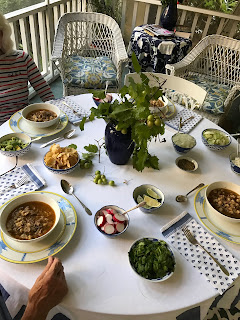My latest food magazines have all had sections on Mexican
cooking and the latest ‘Food and Wine’ was called the Mexican Issue. I am
getting more and more into Mexican cooking and we are going to San Miguel de
Allende in September. I am sure you will hear about that later!
My friends in Wilmington have never eaten posole, so for our
recent visit I thought I would entertain then with the version of posole in the
latest issue of ‘Food and Wine.’
I have discussed posole before and it is basically a Mexican
stew. Depending on the region, the stew could be green from jalapeños
or red with ancho chilies. The toppings are the thing that sets it off---finely
chopped onions, sliced avocado, lime, radishes, lettuce, queso freso. You can
go big or keep it simple, but remember no two bowls ever look alike.
This recipe is long but not hard to do, but it is time
consuming. I spent an afternoon cooking but it does make many meals and I did
freeze several servings. I got some really good Boston butt and pork spareribs
from Whole Foods. The meat makes it so you want good pork. I had dried hominy
from Tucson (Native Seeds---a store with a lot more than seeds) and soaked it
in water overnight so I did not use the canned version. It does made it
somewhat tastier. For a party dish this is great. Serves a lot and people can
have fun with their own toppings.
From ‘Food and Wine’,” The Mexican Issue”, August, 2018.
Posole Rojo
1 (3-lb.) boneless pork shoulder (Boston butt), trimmed and
cut into 2-inch pieces
1 (3-lb.) rack pork spareribs, cut in half crosswise
6 qt. water, plus more
2 Tbsp. plus 2 tsp. kosher salt, divided
1 large white onion, quartered
3 large garlic cloves
1 (2-inch) piece fresh ginger, peeled
3 bay leaves
1 Tbsp. dried oregano, plus more for serving
3 (25-oz.) cans white hominy, drained and rinsed (about 8
cups)
5 large dried ancho chilies
5 large guajillo chilies (these are not in season so use
more ancho chilies)
2 Tbsp. grapeseed oil
10 (5-inch) corn tostada shells
4 cups thinly sliced iceberg lettuce (from ½ head lettuce)
1 cup crumbled Cotiija cheese (optional) You can find this
cheese at most grocery stores.
8 red radishes, thinly sliced
2 ripe medium-size avocados, thinly sliced
3 limes, halved
Combine pork shoulder, spareribs, 6 quarts water, and 1
tablespoon salt in a large stockpot. Bring to a boil over high, skimming off
and discarding foam from surface during first 10 minutes of cooking. Place
onion, garlic, ginger, bay leaves, and oregano in center of a large piece of
cheesecloth, gather edges of cheesecloth together, and secure with twine. Add
to pot; reduce heat to medium-low and gently simmer, uncovered, 1 hour and 30
minutes.
Remove cheesecloth bundle from pot. Remove onion, garlic,
and ginger, set aside. Discard bay leaves and oregano. Add hominy to pot;
simmer over medium-low, uncovered, until rib bones can be easily removed from
spareribs, about 1 hour and 30 minutes.
While pork mixture simmers. Split ancho chilies; remove and
discard stems and seeds. Place half of the chilies in a large, deep skillet
over medium. Cook, turning occasionally, until toasted evenly on both sides,
about 1 minute. Remove to a plate; repeat procedure with remaining chilies.
Return all toasted chilies to skillet; add water just to cover chilies. Bring
to a gentle simmer over medium; cook until chilies are soft and rehydrated,
about 15 minutes. Remove from heat; cool slightly, about 15 minutes. Drain
chilies, reserving cooking liquid. Taste cooking liquid. If it tastes bitter,
discard. If it tastes faintly of raisins, reserve ½ cup.
Transfer dehydrated chilies and either the reserved ½ cup
chili cooking liquid or ½ cup water to a blender. Add onion, garlic, ginger,
and 1 tablespoon salt. Process until smooth, adding splashes of stock from pork
mixture in stockpot as needed to achieve consistency of applesauce, about 1
minute. Pour through a fine wire-mesh strainer into a bowl; discard solids.
Heat oil in a 10-inch skillet over medium-high. Carefully
pour strained chili mixture into skillet. (Mixture will splatter.) Cook,
stirring often, until reduced by half and darkened in color, about 30 minutes.
Remove from heat, and set aside.
When pork mixture has finished simmering, remove spareribs
from stockpot, and set aside until cool enough to handle, about 5 minutes.
Remove and discard rib bones and tendons from spareribs. Chop meat into
bite-size pieces, and return to stockpot. Stir in reserved chili sauce. Bring
to a simmer over medium-low; cook until flavors meld, about 1 hour. Skimming
fat from surface, if desired. Stir in remaining 2 teaspoons salt.
To serve, place tostada shells; lettuce; Cotija, radishes;
avocados; and limes in separate bowls. Ladle soup evenly among 10 large bowls.
For each serving, place a pinch of oregano between palms; rub over and into
soup to release its aroma.
This was a great hit! Our friends loved it.






























